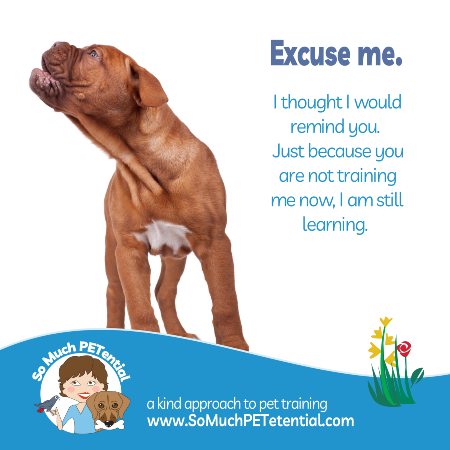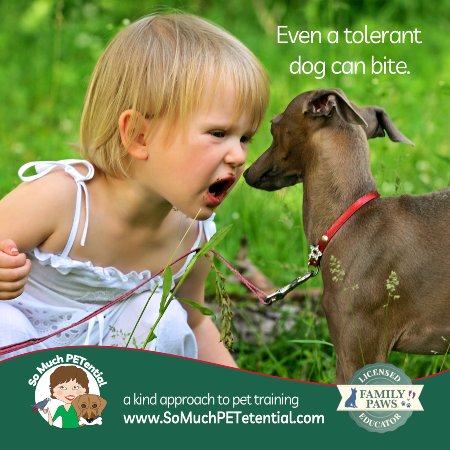Parents, this is an important reminder that your infants, toddlers and kids are ALWAYS watching you, AND learning from your behavior. Trusted adults and parents are ALWAYS teaching by modeling behaviors – for the good and the bad. What kids see you doing to and with your dog, they may try themselves. The problem is kids doing certain behaviors to and with your dog could be a safety risk; and could be teaching your dog to stay away.

You, your dog and your child are also learning from each interaction, positive and negative associations. When one of you does something to cause the other to get over stimulated, uncomfortable, stressed, worried, that experience will go into the learned history vault. Interactions that involve feeling heard, creating comfort and joy, and relaxation also go into that learned history vault.
That vault helps humans and non-humans predict how future interactions and experiences may cause us to feel and behave.
I digressed.
My point is, parents and trusted adults, YOU play an important role in teaching your children how to be someone their dog will WANT to spend time around. Practice modeling and teaching your children what they can and should be doing to help your dog feel comfortable, safe and happy.
What is happening in the video below of a father and daughter playing with their family dog?
While interacting with their dog on the floor, the father pushes his hand toward their dog’s open mouth, and even pushing the dog’s muzzle toward his daughter. He then leans over his dog and gets more forceful with his pushing into their dog. When he pushes their dog away, to where the dog slides on the floor and rolls over, their dog is clearly showing signs of not wanting more.
What dog body language do I see then?
It looks like their dog is starting to try and push that hand away. When their dog is pushed away, as he is getting up, his body is arched and leaning away from the father. When he gets up, he avoids the father and moves away.
What should you as a parent or trusted adult do to help your family dog and child succeed?
Being Dog Aware is such an important piece when it comes to helping that relationship between kids and dogs succeed and practicing dog bite prevention. After all, no one enjoys being around someone else who makes them feel stressed, worried, and afraid.
No one enjoys having valued things taken from them, being scolded for doing something that fulfilled a need at the time, for having their personal space invaded, for being jumped on or having a body part pulled. Many don’t like being in the middle of chaos, or, if they do, may tend to get amped up too which can lead to unwelcome behaviors.
Being Dog Aware (a phrase coined by Family Paws, from which I am a licensed parent educator) involves getting to know your dog’s body language and sensitivities. It also involves learning about what may be a potential stressor for your dog, your dog’s ability to recover from stress, and your dog’s needs. Additionally, it includes being aware of the environment – including the activity of other people such as a baby or child – and how that can impact your dog.
Choose Your Time And Place Wisely
In one of our group discussions through Family Paws, someone had shared an experience when, after her child saw her clipping her dog’s toe nails, that her child thought he would try it too. She saw it and redirected her child before anything happened; however, that was a wakeup call.
When you need to do things for or to your dog, pause and ask yourself if it is something that you want your child to practice.
Remember, there are just so many ways that it could go wrong when your child tries to emulate what he/she saw you do. Your dog’s threshold for escalating distance increasing behaviors may be a lot lower around your child, and your dog is learning from experience whether or not good things happen in the presence of your son or daughter.
THIS ALSO GOES FOR PUNISHMENT. If you yell at your dog or take something your dog has in his possession, or another action more aversive, and your child watches you…Yes, there is a likelihood that your child may try it too.
Model And Practice These Behaviors With Your Kids
Inviting your dog to come to you instead of approaching your laying dog.
Sitting beside your dog instead of leaning over or hugging your dog.
Giving your dog things your dog values instead of taking things away from your dog.
Giving your dog distance while you dog is eating instead of getting into his space.
Staying away from your dog when your dog is in his crate or other ‘alone spot’ instead of getting into his space.
Doing loud and wild behaviors away from your dog instead of yelling, running and jumping in the presence of your dog.
Feeding your dog treats by staying in front of your dog and feeding with either an open palm or by putting treats on the ground instead of leaning over toward your dog and holding the treat in tightly held fingers.
Petting your dog by beginning under his chin and, if your dog wants more, then moving slowly over his body, pausing after a count to 10 and then seeing if your dog asks for more…instead of reaching over your dog’s head and moving your hand in erratic ways without stopping.
NOTE: please click here to learn more about the dog consent to pet test.
Practice understanding your dog’s body language.
Some ways your dog will tell you he wants space or the activity to stop:
a yawn
tense facial muscles
furrowed brow
tongue flick
body shake off (when not wet)
turning or moving away
change in breathing
whites showing around the eye pupils (called whale eyes)
roll over to expose belly (with tense muscles and either looking away or staring at you)
tail tucked
closed mouth
body made to look smaller
Red Alert dog warning signs
growling
snarling
lunging
snapping
deep barking
stiff body staring directly at the trigger
Note that if you see those Red Alert signs, you more than likely have missed your dog’s earlier discomfort signs and your dog has had to escalate his behavior. This is a time to intervene immediately and give your dog space. Don’t punish your dog for communicating as you will be taking away his last defensive communication before resulting in something worse (a bite). Instead, come up with a plan for preventing that escalation in the future. This may be a time to reach out to a trainer who uses and teaches positive strategies for behavior change.







